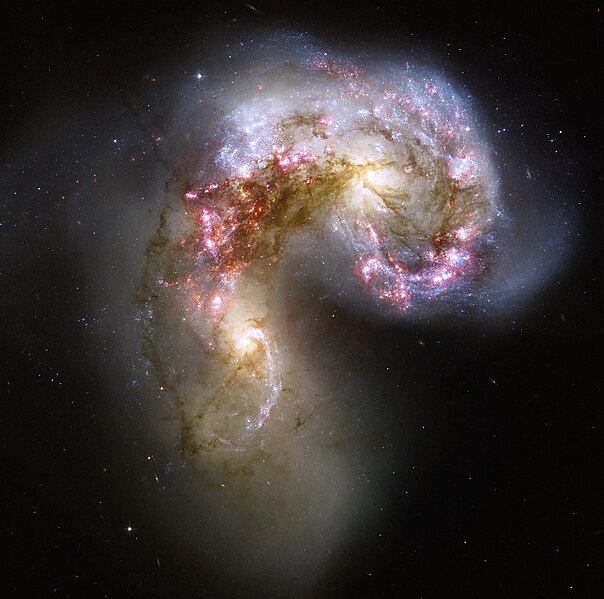Dosiero:Antennae galaxies xl.jpg

Grandeco de ĉi antaŭvido: 604 × 599 rastrumeroj. Aliaj distingivoj: 242 × 240 rastrumeroj | 484 × 480 rastrumeroj | 774 × 768 rastrumeroj | 1 032 × 1 024 rastrumeroj | 2 064 × 2 048 rastrumeroj | 3 915 × 3 885 rastrumeroj.
Bildo en pli alta difino ((3 915 × 3 885 rastrumeroj, grandeco de dosiero: 14,64 MB, MIME-tipo: image/jpeg))
Dosierhistorio
Alklaku iun daton kaj horon por vidi kiel la dosiero tiam aspektis.
| Dato/Horo | Bildeto | Grandecoj | Uzanto | Komento | |
|---|---|---|---|---|---|
| nun | 18:05, 23 apr. 2007 |  | 3 915 × 3 885 (14,64 MB) | WilliamKF | == Description == This new NASA Hubble Space Telescope image of the Antennae galaxies (NGC 4038 & 4039) is the sharpest yet of this merging pair of galaxies. During the course of the collision, billions of stars will be formed. The brightest and most comp |
Dosiera uzado
La jenaj paĝoj ligas al ĉi tiu dosiero:
Suma uzado de la dosiero
La jenaj aliaj vikioj utiligas ĉi tiun dosieron:
- Uzado en af.wikipedia.org
- Uzado en ar.wikipedia.org
- مجرة
- بوابة:علم الفلك/تصنيفات
- مقراب هابل الفضائي
- تشكل وتطور المجرات
- مجرة انفجار نجمي
- فهرس المجرات وعناقيد المجرات
- فهرس كالدويل
- ويكيبيديا:صور مختارة/الفضاء والكون/نظرة إلى الأعلى
- بوابة:علم الفلك/صورة مختارة
- أطلس المجرات الغريبة
- بوابة:نجوم/مجرة
- ويكيبيديا:ترشيحات الصور المختارة/مجرتا الهوائيات
- ويكيبيديا:صورة اليوم المختارة/أبريل 2018
- قالب:صورة اليوم المختارة/2018-04-23
- بوابة:علم الفلك/صورة مختارة/60
- NGC 4038
- ويكيبيديا:صورة اليوم المختارة/أبريل 2020
- قالب:صورة اليوم المختارة/2020-04-23
- ويكيبيديا:صورة اليوم المختارة/مارس 2023
- قالب:صورة اليوم المختارة/2023-03-04
- Uzado en ar.wiktionary.org
- Uzado en arz.wikipedia.org
- مجره
- بوابة:علم الفلك/تصنيفات
- ESO 499 12 (مجره)
- VCCA 42 (مجره)
- LEDA 21644 (مجره)
- LEDA 83336 (مجره)
- LEDA 42596 (مجره)
- UGC 7485 (مجره)
- SDSSCGB 31599.1 (مجره)
- LEDA 2458152 (مجره)
- ESO 138 9 (مجره)
- NGC 3887 (مجره)
- ان جى سى 4697 (مجره)
- NGC 2549 (مجره)
- NGC 1249 (مجره)
- NGC 4517 (مجره)
- IC 3499 (مجره)
- IC 3446 (مجره)
- IC 1251 (مجره)
- IC 625 (مجره)
- NGC 3924 (مجره)
- UGC 1198 (مجره)
- NGC 4350 (مجره)
- NGC 4951 (مجره)
- ان جى سى 1515 (مجره)
Vidi plian ĝeneralan uzadon de ĉi tiu dosiero.



